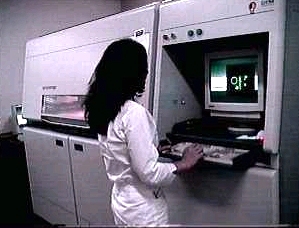Selective laser sintering
From Wikipedia, the free encyclopedia

Selective laser sintering is an additive rapid manufacturing technique that uses a high power laser (for example, a carbon dioxide laser) to fuse small particles of plastic, metal, ceramic, or glass powders into a mass representing a desired 3-dimensional object. The laser selectively fuses powdered material by scanning cross-sections generated from a 3-D digital description of the part (for example from a CAD file or scan data) on the surface of a powder bed. After each cross-section is scanned, the powder bed is lowered by one layer thickness, a new layer of material is applied on top, and the process is repeated until the part is completed.
Compared to other rapid manufacturing methods, SLS can produce parts from a relatively wide range of commercially available powder materials, including polymers (nylon, also glass-filled or with other fillers, and polystyrene), metals (steel, titanium, alloy mixtures, and composites) and green sand. The physical process can be full melting, partial melting, or liquid-phase sintering. And, depending on the material, up to 100% density can be achieved with material properties comparable to those from conventional manufacturing methods. In many cases large numbers of parts can be packed within the powder bed, allowing very high productivity.
SLS is performed by machines called SLS systems; the most widely known model of which is the Sinterstation SLS system. SLS technology is in wide use around the world due to its ability to easily make very complex geometries directly from digital CAD data. While it began as a way to build prototype parts early in the design cycle, it is increasingly being used in limited-run manufacturing to produce end-use parts. One less expected and rapidly growing application of SLS is its use in art.
SLS was developed and patented by Dr. Carl Deckard at the University of Texas at Austin in the mid-1980s, under sponsorship of DARPA. A similar process was patented without being commercialized by R.F. Housholder in 1979.
Unlike some other Rapid Prototyping processes, such as Stereolithography (SLA) and Fused Deposition Modeling (FDM), SLS does not require support structures due to the fact that the part being constructed is surrounded by unsintered powder at all times.
[edit] External links
| This article's external links may not follow Wikipedia's content policies or guidelines. Please improve this article by removing excessive or inappropriate external links. |
- The Low-Volume Manufacturers Association
- Beeeeeam Related News Releases
- Castle Island's Worldwide Guide to Rapid Prototyping
- Comparison chart of rapid prototyping technologies at XPress3D.com
- SLS prototype technology overiew, advantages, and materials - ProtoCAM
- Metal sculptures made using SLS technology
- SLS metal sculptures at bulatov.org


